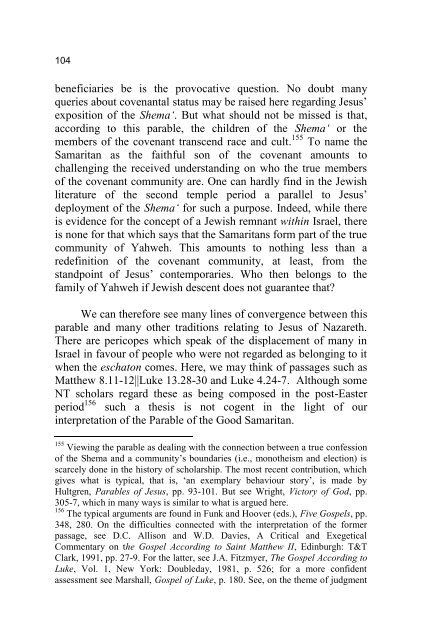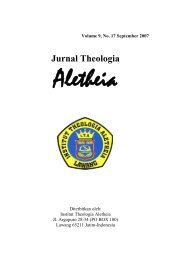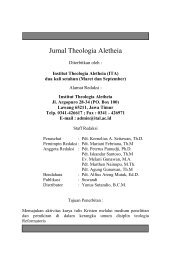download - Sekolah Tinggi Theologia Aletheia Lawang
download - Sekolah Tinggi Theologia Aletheia Lawang
download - Sekolah Tinggi Theologia Aletheia Lawang
Create successful ePaper yourself
Turn your PDF publications into a flip-book with our unique Google optimized e-Paper software.
104<br />
beneficiaries be is the provocative question. No doubt many<br />
queries about covenantal status may be raised here regarding Jesus‘<br />
exposition of the Shema‗. But what should not be missed is that,<br />
according to this parable, the children of the Shema‗ or the<br />
members of the covenant transcend race and cult. 155 To name the<br />
Samaritan as the faithful son of the covenant amounts to<br />
challenging the received understanding on who the true members<br />
of the covenant community are. One can hardly find in the Jewish<br />
literature of the second temple period a parallel to Jesus‘<br />
deployment of the Shema‗ for such a purpose. Indeed, while there<br />
is evidence for the concept of a Jewish remnant within Israel, there<br />
is none for that which says that the Samaritans form part of the true<br />
community of Yahweh. This amounts to nothing less than a<br />
redefinition of the covenant community, at least, from the<br />
standpoint of Jesus‘ contemporaries. Who then belongs to the<br />
family of Yahweh if Jewish descent does not guarantee that?<br />
We can therefore see many lines of convergence between this<br />
parable and many other traditions relating to Jesus of Nazareth.<br />
There are pericopes which speak of the displacement of many in<br />
Israel in favour of people who were not regarded as belonging to it<br />
when the eschaton comes. Here, we may think of passages such as<br />
Matthew 8.11-12||Luke 13.28-30 and Luke 4.24-7. Although some<br />
NT scholars regard these as being composed in the post-Easter<br />
period 156 such a thesis is not cogent in the light of our<br />
interpretation of the Parable of the Good Samaritan.<br />
155 Viewing the parable as dealing with the connection between a true confession<br />
of the Shema and a community‘s boundaries (i.e., monotheism and election) is<br />
scarcely done in the history of scholarship. The most recent contribution, which<br />
gives what is typical, that is, ‗an exemplary behaviour story‘, is made by<br />
Hultgren, Parables of Jesus, pp. 93-101. But see Wright, Victory of God, pp.<br />
305-7, which in many ways is similar to what is argued here.<br />
156 The typical arguments are found in Funk and Hoover (eds.), Five Gospels, pp.<br />
348, 280. On the difficulties connected with the interpretation of the former<br />
passage, see D.C. Allison and W.D. Davies, A Critical and Exegetical<br />
Commentary on the Gospel According to Saint Matthew II, Edinburgh: T&T<br />
Clark, 1991, pp. 27-9. For the latter, see J.A. Fitzmyer, The Gospel According to<br />
Luke, Vol. 1, New York: Doubleday, 1981, p. 526; for a more confident<br />
assessment see Marshall, Gospel of Luke, p. 180. See, on the theme of judgment




